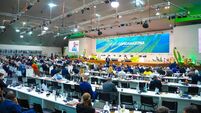Bill will eventually arrive if we continue to trade environmental relief for short-term relief

The new directive expands the list of priority substances to include pharmaceuticals, bisphenols, and the family of per- and poly-fluoroalkylated 'forever chemicals'. Picture: iStock
Every year, swimmers across the country see the same warning signs: Do not swim — water quality advisory.
Beneath those red flags lies a deeper story about how Ireland’s natural environment is changing, and how decisions made in Brussels and Dublin over the next few years will shape our rivers, lakes, and coasts for decades to come.
The Environmental Protection Agency’s 2025 assessment confirms what many communities already sense: Ireland’s waters are under pressure.
Just over half of rivers, lakes, and estuaries are now in good or high ecological status, down slightly from previous years. Groundwater remains strong, but coastal and estuarine waters continue to decline. The culprits are well-known — nutrient run-off from agriculture and gaps in wastewater treatment — yet, despite years of investment, national trends remain stubbornly flat.
Against that backdrop, the EU has agreed to the most ambitious update of its water-pollution rules in a generation. The new directive expands the list of priority substances to include pharmaceuticals, bisphenols, and the family of per- and poly-fluoroalkylated (PFAS) “forever chemicals”.
CLIMATE & SUSTAINABILITY HUB
It will also introduce effect-based monitoring, where biological tests detect the combined toxicity of chemical mixtures instead of measuring single pollutants.
For Ireland, this is both a challenge and an opportunity. Implementing these standards will require new analytical capability, upgraded wastewater systems, and far more detailed data collection. However: it will also bring clarity: We’ll finally see what’s really in our water, and where interventions are most effective.
At the same time, Europe’s common agricultural policy (Cap) — the main vehicle for linking farm income to environmental performance — is under political pressure. In response to farmer protests, the European Commission has proposed simplifying the rules and softening some “green conditionality” requirements.
That may ease immediate tensions, but it risks pulling in the opposite direction to the new water chemicals law. Agriculture is Ireland’s dominant land use and the main source of nutrient pressure. Weakening the link between public payments and measurable environmental outcomes would make it even harder to reverse the downward trend in water quality.
Ireland’s nitrates derogation illustrates that tension perfectly. Intensive dairy regions have long been allowed to apply higher levels of organic nitrogen (up to 250kg N/ha) under strict conditions. However, because water quality failed to improve in key catchments, the European Commission required that limit to fall to 220kg N/ha in many areas from January 2024, with more reductions possible after 2025.
This change may seem technical, but it carries real consequences.
Yet the rationale is simple: The higher the nutrient load, the greater the pressure on rivers, estuaries, and drinking-water sources. The derogation was always conditional on environmental performance; the science finally caught up.
Beyond nutrients, a new class of concern is emerging. PFAS — the “forever chemicals” used in firefighting foams, coatings, and everyday products — are now turning up everywhere in our environment and in our bodies. They don’t break down, they travel long distances, and removing them from drinking water requires costly activated carbon or membrane systems.
The EU’s new standards will, for the first time, make these compounds a compliance issue.
If Ireland invests now in smarter monitoring and targeted farm supports, the benefits will ripple widely: Cleaner bathing waters, healthier ecosystems, and lower long-term treatment costs.
But if we continue to trade environmental ambition for short-term relief, the bills will eventually arrive in rising water charges, lost tourism days, and shrinking biodiversity.
Ireland already has the science and infrastructure to lead on this. EPA and Lawpro teams have shown that water quality improves when measures are precisely located, for example, targeting phosphorus hotspots rather than blanket rules.
New sensors, isotope tracing, and machine-learning models can pinpoint sources more accurately than ever.
What’s missing is alignment. Environmental law, Cap incentives, and local practice must point in the same direction.
Farmers deserve clarity; If they reduce losses, the reward should be real.
Regulators need consistency; If rules tighten, they must be matched with support and communication.
The public deserves transparency; Open data that shows where progress is happening and where it isn’t.
If Ireland seizes this moment, we could see measurable improvements in rivers and lakes by the mid-2030s, stabilising coastal waters and reducing chemical exceedances — including the challenging, bioactive compounds that current tests often miss.
But if green strings are loosened while chemical standards tighten, we risk another decade of decline, mounting EU non-compliance risks, and higher treatment costs later. The choice isn’t between farms and the environment, it’s between planning and paying.
Ireland’s clean-water reputation wasn’t lost overnight, and it won’t be restored easily. It will take evidence, alignment, and honesty about the trade-offs.
The next decade will decide whether we turn the tide, or just learn to swim in murkier waters.
- Jenny Lawler is a lecturer at the School of Biotechnology at Dublin City University















